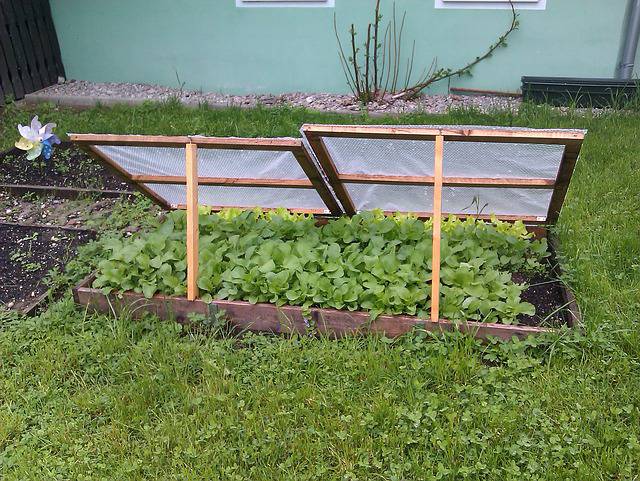Shown is a Cold Frame. Photo via http://ow.ly/RpTPZ
As summer draws to a close, I try to spend every spare moment in my garden. Do you find yourself wishing your garden would continue to flourish right on into the cold-weather months? Well, wish no more! I did some research and found several things you can do to extend the life of your garden. Enjoy!
1.) Keep Your Garden Warm. Row covers made of special fabric can be used to protect items in your garden that are sensitive to colder temperatures. For example, you may drape a row cover over tomato plants, peppers, and eggplants. A row cover also protects your plants from strong winds and harmful insects.
2.) Planting in Succession. Establish the habit of planting seeds every two weeks so you can have a steady supply of vegetables even as the fall begins. For instance, you can plant seeds for radishes, beans, and lettuce every two weeks. You may want to consult a succession gardening chart to use as a guide for planting various types of vegetables.
3.) Plant Vegetables That Flourish in the Cooler Weather. This time of year, it’s a good idea to focus on planting vegetables that grow in cooler temperatures. Some examples include lettuce, spinach, mustard, peas, turnips, cabbage, and cauliflower. You can also plant cilantro, parsley, and other herbs in late summer. I plant basil in my garden each August in honor of my dog, Basil.
4.) Build a Mini-Greenhouse. If you don’t have room for a full-size greenhouse, you may want to try buying or building a miniature one. The glass of a miniature greenhouse lets sunlight in so plants can grow. With a mini-greenhouse, you have control over the temperature of the soil as well as the type of soil you use. This structure provides protection from cold temperatures that might otherwise kill your plants.
5.) Weed Your Garden. Keeping the weeds out of your garden helps your vegetables to continue to grow as fall approaches. You never want weeds to drain nutrients away from the vegetables you plan to enjoy during the cold-weather months.
6.) Try a Cold Frame. A cold frame is another type of structure designed to keep your late summer/fall vegetables safe from cooler temperatures. It is a miniature greenhouse with a glass top that allows sunlight in to warm the plants. Generally, the temperature in a cold frame is about five to ten degrees warmer than the temperature outside.
7.) Look for Early-Variety Plants. Choosing early-variety plants can help you to keep your garden popping. For instance, you may want to plant early-variety tomatoes such as Stupice. The ripening time for these tomatoes is 60 days as opposed to some others that take 85 days to ripen. Checking for early varieties can increase the chances that the plants will ripen before the first frost.
8.) Plant Items in Raised Beds. A raised garden bed can help to keep the soil warm for your late-summer/early-fall vegetables. Plus, the soil in a raised garden bed dries out more quickly than ground soil. You can choose a top-quality soil to put in your raised beds so you’re sure to yield a crop of healthy vegetables right into the fall.
9.) Make a High Tunnel. A high tunnel is essentially a sheet of durable plastic molded over a metal frame. This structure protects plants from the cold temperatures and saturated soil that arrive with the fall. You can move around beneath your high tunnel in order to water plants, pull weeds, etc. In a greenhouse, the plants grow in pots, while in a high tunnel, they grow out of the ground.
10.) Keep Up With Your Watering. Since you’ll be planting seeds with frequency, be sure to give plenty of water to your garden. All of these new seeds and growing plants will need watering on a regular basis to remain free of diseases that can harm or kill them. I’m out in my garden with my watering can each day to make sure my plants are getting all of the H2O they need.
11.) Reconfigure Your Garden. Replacing warmer-weather vegetables with cooler-weather ones is a great way to extend the life of your garden. For example, dig up what’s left of your broccoli and plant lettuce in its place. Or pick the last of your beets and use that space for kale. Remove your pea vines and use that area to plant carrot seeds.
Try some or all of these ideas to make the most of your garden this fall!
![[Avas Flowers] Avas Flowers](https://www.avasflowers.net/newimg/avas-logo-new.png)

